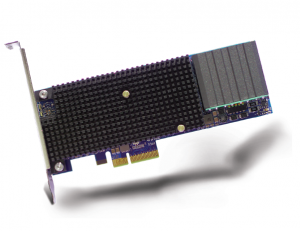 SuperMicro has achieved up to million IOPS in their SYS-6047R-TXRF servers using STEC’s PCIe SSDs (or SSAs as STEC refers to them, for Solid State Accelerators). These servers are based on the Intel Xeon E5-2600 family of CPUs (Socket 2011) and support up to 512GB of RAM.
SuperMicro has achieved up to million IOPS in their SYS-6047R-TXRF servers using STEC’s PCIe SSDs (or SSAs as STEC refers to them, for Solid State Accelerators). These servers are based on the Intel Xeon E5-2600 family of CPUs (Socket 2011) and support up to 512GB of RAM.
STEC’s current PCIe offerings are based on their own silicon, and come in PCIe Gen2 x4 half-height configurations with MLC or SLC.
STEC specifications list the SLC version at 1.4GB/s sustained read throughput and 1GB/s sustained write throughput, with MLC versions getting lower sustained write performance of 600GB. 1.4GB/s is about the limit of Gen2 x4 PCIe storage performance anyway, so STEC isn’t leaving much, if any, performance on the table.
Steady state random performance is listed at 100K read/35K write IOPS for the 240GB SLC variant (at 8K, not 4K transfer sizes). The 480GB and 960GB MLC siblings have 8K steady state performance of 95K read and 22K write IOPS. STEC is also quick to tout their proprietary NAND management techniques and power-loss protection used in each of their products, and the PCIe flavors have them too. Additionally, the SSAs have NAND level redundancy in the event of a die failure, so one NAND die doesn’t take out the whole drive should it meet an untimely demise.
There is no mention of how the 1 million IOPS were achieved, or how many STEC SSAs were utilized, but 1M transactions per second is no joke — you’d need thousands of hard drives to hit that level of performance. In that context, using a couple of PCIe SSDs to accelerate data and applications seems infinitely more appealing. HDDs need a lot of infrastructure in larger installations, while a SuperMicro server with some STEC SSDs doesn’t.
 The SSD Review The Worlds Dedicated SSD Education and Review Resource |
The SSD Review The Worlds Dedicated SSD Education and Review Resource | 